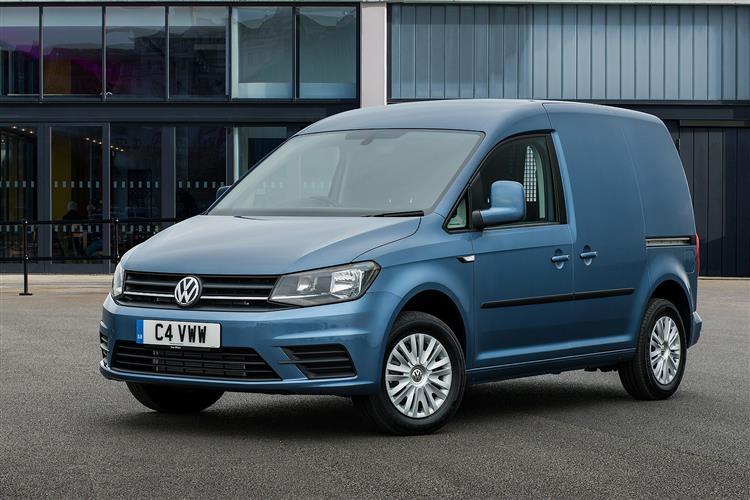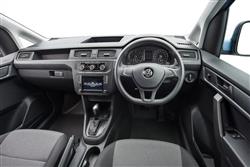CAD CAN (some text hidden) --NONE--
By Jonathan Crouch
Introductionword count: 96
Volkswagen's Caddy van has always rewarded buyers looking for the largest breed of compact van with a quality feel and a depth of design engineering often missing from obvious rivals. Back in 2015, with a more efficient Euro6 engine range, this improved version of the MK3 Type 2K model added a very frugal set of running cost returns to the mix, along with sharper looks, extra technology and class-leading safety. As a result, if you're looking for something Citroen Berlingo, Renault Kangoo or Ford Transit Connect-sized from the 2015-2020 era, it's a difficult option to ignore.
Modelsword count: 11
Compact Van (petrol/diesel) [1.2,1.4 - TSI petrol / 2.0 TDI diesel]
Historyword count: 384
Here's a van that's come a long way. Volkswagen's smallest LCV, the Caddy, has always provided a quality option for buyers seeking compact load-carrying business transport. In recent times though, rivals have been claiming that too. Hence back in 2015, Volkswagen's need for this improved version of the third generation Typ 2K Caddy model, a design that aimed to set benchmarks in efficiency, safety, convenience, comfort and technology. And yes, in quality too. For van customers, the Caddy name dates back to 1995, though back then, all this LCV really offered business buyers was the chance to own a Volkswagen Polo supermini with a metallic shed bolted on the back. In 2003 though, with this MK3 design, Volkswagen got serious, creating a smart all-new model based on underpinnings borrowed from its Golf and Touran passenger cars. The design was assembled in a purpose-built Polish factory and proved to be a huge success, the range quickly expanding to include an extended 'Maxi'-sized version as well as people-carrying 'Caddy Life' MPV variants. By 2015 though, it was clear that another step forward was needed, for by then, every rival in the compact van sector had substantially upped its game. Newer designs like Ford's Transit Connect and the Mercedes Citan, along with uprated versions of competitors like Peugeot's Partner, Citroen's Berlingo, Renault's Kangoo and Fiat's Doblo Cargo were all threatening Volkswagen's market share. Many of these were offering business buyers passenger car-style engine, infotainment and safety technology. Volkswagen had to respond. At first glance, their reaction to the way the LCV market challenged this vehicle might seem a little half-hearted. Look at little closer though and you begin to realise just how fundamental the changes to this fourth generation model really were. Here was a small van that could return over 65mpg, potentially park itself almost unaided and even brake itself to avoid an accident. All this from a vehicle still able to lug up to 735kg and fit in up to 4.2m3 of carriage capacity. A vehicle that could be specified to virtually drive itself on the motorway. And create for you a 'mobile office' wi-fi hotspot when stationary. In short, here we were talking of a new era in van technology. In this form, the Caddy sold until the fourth generation version arrived in mid-2020.
What You Getword count: 438
If at first glance, you're tempted to dismiss the styling changes made to this post-2015-era version of the third generation Caddy as being mere detail alterations, then Volkswagen is keen to put you right. True, not much about the overall look, feel or size of this vehicle was fundamentally changed as part of this facelift but examine this LCV a little closer and you begin to appreciate the sheer depth of thought that's gone into improving it. Here, we're looking at the conventional van version of this design but as before, there are also 'Caddy Kombi', 'Caddy Window van' and 'Caddy Life' variants that can offer various degrees of people carrying capability should you want that. The headlamps, radiator grille and bumper were redesigned as part of this update to form a distinctive horizontal band across the front of the vehicle, while the rising V shape that stretches from the grille edges to the base of the window aims to give the front of the Caddy a more striking appearance. Behind the wheel, the redesigned dashboard looks pretty similar to the previous one, but closer inspection reveals higher quality materials, strong build quality from the Polish factory, rectangular rather than circular air vents and, most importantly, provision for a 5-inch infotainment touchscreen just below the ventilation controls in the centre of the dash - often upgraded to a larger 6.5-inch 'Composition Media' display. What about the practicality of this Caddy? The doors are fractionally bigger than they were on earlier models, 1183mm in width and 1134mm in height, so most of what you want should go in, including a standard euro pallet. Inside, there's a completely level cargo floor with a load space width of 1,340mm, narrowing to 1,172mm between the wheel arches. There was no option for original buyers to specify a higher roof height, so all Caddys got 1,259mm of vertical space. That means a load capacity of 3.2m3 in this standard model. If you need more, then you'll need to be looking at the Caddy Maxi variant, which adds 470mm to the vehicle length, increases interior load length to 2,249mm and ups the load volume to 4.2m3. Size-wise then, most of what you want to carry will probably fit - but what about weight? Well, payloads in this post-2015 model are very similar to what they were before, ranging from 582kg to 735kg, with Gross Vehicle Weights from 2,135kg to 2,350kg. Want to load in from the side? Well, there's a standard sliding door on the left-hand side of the vehicle. This opening provides a loading width of 700m and a loading height of 1,097mm.
To see the full road test text contact us on 0330 0020 227
Pictures (high res disabled)

.jpg)
|
.jpg)
|
.jpg)
| |||
.jpg)
|
.jpg)
|
.jpg)
| |||
.jpg)
|
.jpg)
|
.jpg)
| |||

|
Scoring (subset of scores)
Category: Vans
| Performance | |
| Handling | |
| Comfort | |
| Space | |
| Styling, Build, Value, Equipment, Depreciation, Handling, Insurance and Total scores are available with our full data feed. | |



